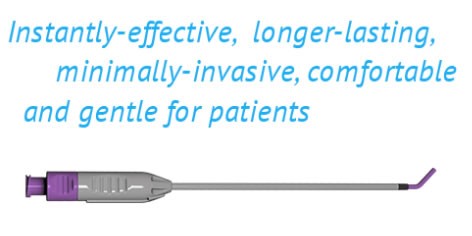The SphenoCath® device is a one-of-a-kind patented, soft, flexible, spaghetti-sized catheter which employs a flexible outer sheath with soft edges for comfort and an inner angled flexible catheter to deliver medication without the use of a needle inside the nasal passageway with maximum patient comfort. The device has a directional arrow for proper orientation within the nostril and can, optionally, include a tungsten tip and barium impregnated sheath for high visibility under fluoroscopic imaging, if needed. Depth markings on the external sheath are also available as an option.
Sphenocath®
Sphenopalatine ganglion blocks have time-tested efficacy when it comes to serious chronic and episodic migrainous pain.
- 2 to 5 minute in-office procedure
- Majority of patients experience immediate relief
- Very low risk
- Very high success rates
- Safe for adults and children
- Reimbursed by most insurance companies & Medicare

Currently, there is very little to offer the chronic headache patient. Nearly two-thirds of patients discontinue prescription medications due to inadequate relief and side-effects.
SPG blocks achieve neuromodulation of the sphenopalatine ganglion complex (SPG). This means that the time-tested efficacy of the procedure has been shown to have both immediate and long-term results. These effects are typically sustained by interrupting the chaotic signaling associated with migraine.
The patented SphenoCath® offers the practitioner the ability to offer a first-line treatment to the chronic headache patient. The SphenoCath® delivers medication that can sustain pain relief in a 15-minute procedure that is comfortable and quick. With the SphenoCath®, an SPG block may be achieved without needles, cotton swabs, atomizer sprays, or systemic narcotics.
Commonly Asked Questions About Sphenocath®
What is the Sphenocath® device?
What is SPG block and why will it help me?
SPG block stands for sphenopalatine ganglion block. The sphenopalatine ganglion is a collection of nerve cells located just under the tissue lining the back of the nose. By applying a local anesthetic to the area, nerve impulses can be temporarily blocked, providing relief from various types of pain. Temporarily blocking the function of the SPG can provide prompt, and sometimes sustained, relief of pain. The patented SphenoCath® is designed to quickly and comfortably deliver medication to the area of the sphenopalatine ganglion.
Some patients experience minor discomfort when the small, soft SphenoCath® is inserted into the nose, but the procedure is not painful when performed correctly. In the past, SPG block was accomplished with a long needle through the side of the head or with a stiff, cotton-tipped applicator through the nose. The patented SphenoCath® uses no needles and is designed to be comfortable and safe for patients.
SPG block using the SphenoCath® takes 2-3 minutes. Patients are encouraged to remain in a flat or reclined position for 10-15 minutes afterward to maximize the benefit of the procedure.
The medication choice is up to your healthcare provider. Most practitioners perform SPG block using a local anesthetic such as lidocaine, the same or similar medication that is injected by a dentist or used to anesthetize a laceration before stitches. With the SphenoCath®, however, no needles are used. The medication is absorbed through the lining of the nose.
What are the side effects or risks with the Spenocath?®
The risks of using the SphenoCath® include irritation to nasal cavity or mucosa, nose bleeding, and/or mild pain.
Why haven't I heard of SPG block before?
SPG block has been done for many years but, until the invention of the patented SphenoCath®, the procedure has been difficult, uncomfortable, and offered only by a few practitioners. Now SPG blocks can be done quickly, easily, and comfortably, and by a wide variety of practitioners.
What about my headache medications?
Do not change your headache medications unless instructed to do so by your provider.
